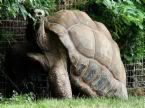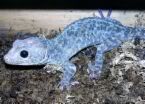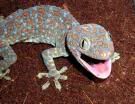
SCIENTIFIC CLASSIFICATION
COMMON NAME: Aldabra tortoise, giant tortoise
KINGDOM: Animalia
PHYLUM: Chordata
CLASS: Reptilia
ORDER: Testudines (somes sources cite as Chelonia)
FAMILY: Testudinidae
GENUS SPECIES: Geochelone (land turtle) gigantea (giant)
FAST FACTS
DESCRIPTION: They are dark gray to black in color with a highly domed thick carapace, a very long neck to aid in food gathering, and short, thick legs.
MALE Males have longer, thicker tails than females.
SIZE: MALE Mature males have an average carapace (shell) length of 122 cm (4 ft.)
FEMALE Adult female carapace length averages 91 cm (3 ft.).
WEIGHT: MALE Adult males up to 250 kg (550 lb.) or more
FEMALE Mature females average 159 kg (350 lb.)
DIET: Though it feeds primarily on vegetation, the Aldabra tortoise is flexible and opportunistic in its diet. In order to obtain enough nourishment for survival, the tortoise may supplement its diet with small invertebrates and even carrion (including dead tortoises).
INCUBATION: Incubation is temperature dependant: in warm temperatures, eggs hatch in about 110 days; in cool temperatures, eggs take 250 days to hatch.
CLUTCH SIZE Typically, the females lay between 4-14 eggs, of which less than one half are fertile. Within zoological settings, the average clutch size may be seen to increase, approaching 9-25 eggs.
BREEDING PERIOD In healthy, uncrowded populations, a second clutch (laying) within the same breeding season is likely.
SEXUAL MATURITY: Sexual maturity is determined by size rather than by age; most species begin to reproduce when they reach approximately half their full-grown size, usually around 25 years of age.
LIFE SPAN: Unknown, probably easily lives over 100 years
RANGE: The entire wild population of Aldabras is restricted to the Aldabra Atoll (a small group of coral islands in the island nation of Seychelles, north of Madagascar).
HABITAT: There are many different habitats on the islands where tortoises can be found, including scrub, mangrove swamp, and coastal dune. The largest concentrations of tortoises are found on the grasslands called platins.
POPULATION: GLOBAL No data
STATUS: IUCN Vulnerable CITES Appendix II USFWS Not listed
FUN FACTS
1. The Aldabra tortoise is the largest animal on the atoll. The tortoises fill a niche very similar to the one occupied by elephants in Africa and Asia. As with elephants, they are the main consumers of vegetation and noticeably alter the habitat during their search for food. Tortoises have been known to knock over small trees and shrubs to obtain nutritious leaves. This makes pathways and clearings within the forestlands for other animals. Seeds pass through the tortoise's digestive tract and eventually become food for many other species.
2. The Aldabra tortoise is one of the longest-lived animals on earth, if not the longest. No one knows exactly how long these animals are capable of living, but they are believed to easily surpass 100 years. So far, the tortoises studied have outlived the scientists studying them, and proper records have not been maintained.
ECOLOGY AND CONSERVATION
The Aldabra tortoise is the only remaining species out of 18 former species of tortoise that once flourished on the islands of the Indian Ocean. The others went extinct because of hunting by sailors and the predation of eggs and hatchlings by introduced species such as rats, cats, and pigs.
This was one of the first species to be protected in order to ensure its survival for the future. Charles Darwin and other notable conservationists of the day along with the governor of Mauritius set aside a captive breeding population on Mauritius as well as protecting the Aldabra Atoll.
TOKAY GECKO


SCIENTIFIC CLASSIFICATION
COMMON NAME: tokay gecko, common gecko
KINGDOM: Animalia
PHYLUM: Chordata
CLASS: Reptilia
ORDER: Squamata
FAMILY: Gekkonidae
GENUS SPECIES: Gekko (Malayan) gecko (named for the barking sound the Asian species makes)
FAST FACTS
DESCRIPTION: Greenish gray lizard with gray and orange-brown spots covering body; body is slender with a large head; eyes are prominent in all species; broad fleshy toes with inner folds
SIZE: 25-30 cm (10-12 in.) average total body length; maximum length of 35 cm (14 in.)
WEIGHT: No data
DIET: Insects, baby birds, and small mammals such as nesting mice
INCUBATION: 100-182 days
CLUTCH SIZE 2 eggs
SEXUAL MATURITY: 3 years
LIFE SPAN: Up to 20 years
RANGE: Southeast Asia and Malayan Isles; northeast China, Indonesia, and Thailand
HABITAT: Arboreal; bushes, trees and on or around rocks POPULATION: GLOBAL No data
STATUS: IUCN No data CITES Not listed USFWS Not listed
FUN FACTS
1. Nearly all geckos have a voice, ranging from a small squeak to the deafening whistles of the African whistling gecko.
2. The gecko sticks its eggs to walls or rocks near cracks or holes. More than one female may use the same 'nest'. The eggs are soft-shelled at first with a very sticky surface. They harden soon after they are laid.
3. Tokays have padded toes with sticking power, which has long been the obsession of scientists. However, knowing what research has found, it's not surprising. Each of its four feet has five toes. Each toe has fine hairs 1/10 mm long, packed at 5,000 hairs per sq mm (3,000,000 per sq inch). Each hair has 400-1,000 branches that end in a spatula-like structure about 1/50,000 inch long. Each hair is strong enough to support an ant's weight. One million hairs can support a small child!
4. Tokay Geckoes are solitary creatures, only encountering the opposite sex during the breeding season. They are territorial and will defend their space against intruders of the same species and of other species, ensuring less competition for food.
5. These geckoes can inflict severe bites if they are sufficiently threatened.
6. Their nose is used for breathing and also for detecting scents. A large number of sensory cells on a membrane in the nostrils and the Jacobson's organ help tokays to hunt. Their tongue is used to carry scent particles to the holes in their palate. These particles are then transported to the Jacobson's organ, which tells their brain about the environment (smell and taste).
7. They have folds of skin that prevent them from casting a shadow while resting on a tree. By opening up the skin fold completely, it allows them to blend in with the tree bark.
8. Another important feature of the tokay is its ability to cast off its tail in defense and later regenerate a new one. The cast off part will continue to move for several minutes, giving the gecko time to escape. It takes approximately three weeks for these geckoes to completely regenerate a new tail although it is usually never as long as the original tail.
9. In parts of Southeast Asia, tokays are regarded as bringers of luck, good fortune, and fertility.
ECOLOGY AND CONSERVATION
Tokay geckos are important in controlling pest populations such as cockroaches and locusts. Unfortunately, because they are able to pack a powerful bite, most people do not want them around. Though they are not in immediately danger, habitat destruction and the pet trade will eventually take a toll on their populations.







0 comments:
Post a Comment